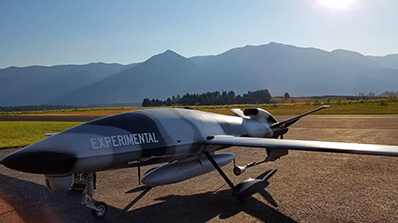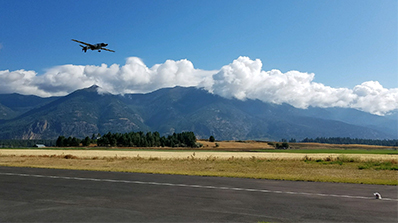
A partnership between the Nevada National Security Site (NNSS) and H3D, Inc. is improving the ability to detect and identify radioactive sources. The partnership holds promise for using unmanned aerial systems to measure radioactivity in places where manned aircraft access may be a challenge.
Mission Support and Test Services, the management and operating contractor for the NNSS, and H3D, Inc. have entered into a cooperative research and development agreement (CRADA) to test H3D’s high-efficiency radiation detector on unmanned aerial systems provided by the NNSS.
The NNSS Remote Sensing Laboratory (RSL) relies upon state-of-the-art sensors to detect, measure and identify radioactive sources. The sensors are used by the NNSS’ counterterrorism and radiological incident response teams stationed at Nellis Air Force Base in Nevada and at Joint Base Andrews in the National Capitol Region.
As part of the research and development efforts, scientists and engineers from the NNSS integrated the H3D sensors with unmanned aerial systems, creating a more flexible and agile vehicle for measuring radiation. The first tests were completed in September at the Unmanned Systems Inc. (USI) facility in Columbia Falls, Montana and data analysis was finalized in December.

“The first test flights provided even better results than we anticipated,” said NNSS Site-Directed Research and Development (SDRD) Program Manager Howard Bender. “This CRADA has allowed us to leverage commercialized radiation detectors and UAS technology, enabling us to deploy them an entirely new way and develop a new asset to respond to nuclear emergency situations.”
H3D’s technology grew out of research conducted at the Nuclear Engineering department at the University of Michigan. The technology was further funded in large part by the Defense Threat Reduction Agency (DTRA). The ongoing partnership between H3D and the NNSS will provide research into the trade-offs between sensitivity and resolution of the compact radiation detectors. Integrating the sensor technology with unmanned aerial vehicles has the potential to enhance the next generation radiation detection capabilities for RSL and other emergency response agencies.
“H3D views aerial radiation detection platforms as a key growth area for our organization and are fortunate to have NNSS as a partner in this effort,” stated H3D President Willy Kaye.
Cooperative research and development agreements like this one allows the federal government to partner with private entities to complement the National Nuclear Security Administration missions, foster mutually beneficial partnerships to facilitate cutting-edge research and development, enable U.S. scientific discovery and economic competitiveness, and improve our security and quality of life through innovations in science and technology.
